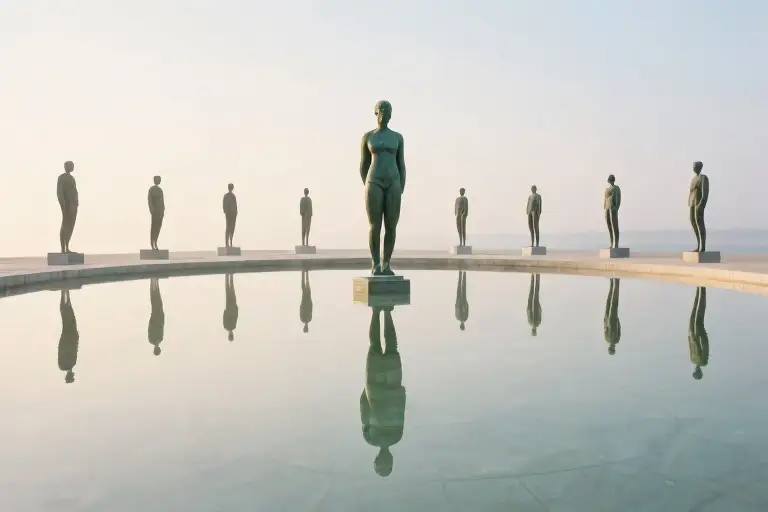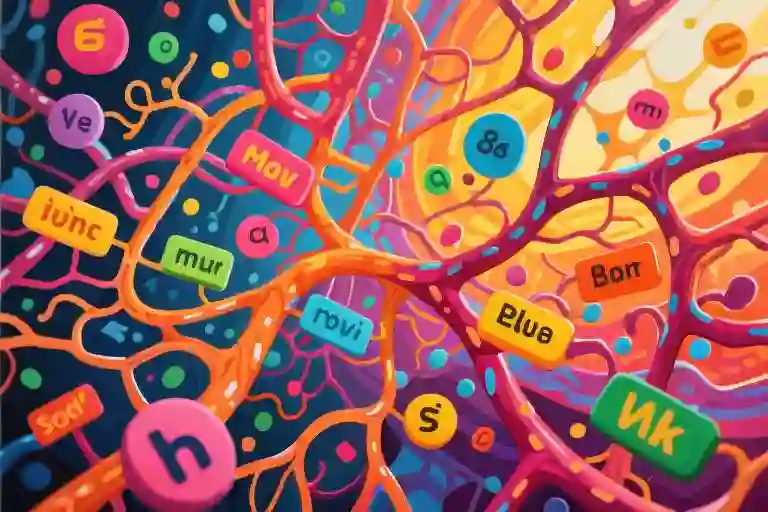The glass of water sitting on your desk right now—how much of it are you truly seeing? If your answer is “all of it,” neuroscience might suggest otherwise. What we perceive as complete reality is, in fact, just one half of a dualistic existence our brains construct. This isn’t about optical illusions or visual tricks; it’s the fundamental architecture of human cognition.
Picture a bronze statue standing at the center of a circular reflecting pool, surrounded by twelve observers stationed at equal intervals. From their fixed positions, each person sees only the side facing them—the curve of a shoulder blade, the tilt of a chin, perhaps one outstretched hand. The other half remains perpetually hidden, not because it doesn’t exist, but because perspective determines visibility. This statue-in-the-pool metaphor mirrors how our selective attention works: your conscious awareness illuminates certain aspects of reality while leaving others in cognitive shadow.
Cognitive scientists call this phenomenon perceptual polarity—the inherent duality of human awareness. Like positive and negative charges in physics, our perception splits reality into seen and unseen components. The famous “invisible gorilla” experiment demonstrated this dramatically: when focused on counting basketball passes, over half of participants completely missed a person in a gorilla suit walking through the scene. Your brain isn’t malfunctioning when this happens; it’s prioritizing efficiency over completeness.
This perceptual limitation carries profound implications. Consider how often conflicts arise because two people insist they’re seeing “the whole truth.” Colleagues clash over project strategies, partners argue about relationship dynamics, nations misunderstand cultural intentions—all variations of observers standing at different points around the same statue. The part we don’t see isn’t less real; it’s simply outside our current frame of reference.
What makes this cognitive blind spot particularly insidious is how convincingly our brains fill in the gaps. Your visual cortex automatically constructs a complete image from partial data, just as your mind creates coherent narratives from fragmented experiences. This explains why eye witness testimony often contradicts video evidence, and why we remember events differently than how they actually occurred.
Yet this perceptual polarity isn’t a design flaw—it’s a survival mechanism. If we attempted to process all available sensory data simultaneously, our neural systems would overload within seconds. The cocktail party effect demonstrates this beautifully: amidst dozens of conversations, your brain filters everything except the discussion you’re engaged in… until someone says your name, proving your subconscious was monitoring everything all along.
As we navigate an increasingly complex world, understanding this 50% principle becomes crucial. Every decision, every judgment, every belief we hold comes with an invisible counterpart—the aspects we haven’t considered, the data we’ve filtered out, the perspectives we haven’t encountered. The statue remains whole even when we only perceive fragments.
This realization invites an important shift from “What am I seeing?” to “What might I be missing?” It’s the difference between assuming your view represents complete reality and recognizing it as one slice of a multidimensional truth. The most innovative thinkers, the most empathetic leaders, the most effective problem-solvers all share this awareness—they know their perception comes with built-in blind spots, and they’ve developed habits to compensate.
Your morning coffee, the project proposal on your screen, the conversation you had yesterday—they all have hidden dimensions waiting to be discovered. Not through sharper vision, but through the willingness to circle the pool.
The Blind Spots Built Into Your Brain
Our minds come with factory-installed blinders. This isn’t a design flaw – it’s how human perception fundamentally operates. Like specialized cameras with fixed lenses, our brains automatically focus on certain aspects of reality while leaving others in permanent shadow.
The Neuroscience of Selective Attention
Modern brain scans reveal why we’re cognitively ‘half-blind.’ The prefrontal cortex – your brain’s CEO – constantly makes executive decisions about what information deserves attention. Research from MIT’s Department of Brain and Cognitive Sciences shows we process less than 0.1% of available sensory data at any moment.
This selective attention mechanism creates what psychologists call ‘inattentional blindness.’ In the famous ‘invisible gorilla’ experiment by Simons and Chabris, 50% of participants failed to notice a person in a gorilla suit walking through a basketball game because they were counting passes. Your brain doesn’t just miss details – it can overlook entire realities when focused elsewhere.
Kant’s Unknowable ‘Thing in Itself’
Philosopher Immanuel Kant described this limitation centuries before MRI machines. His concept of the ‘noumenon’ (the thing as it exists independently) versus ‘phenomenon’ (the thing as we experience it) explains why we only perceive reality through mental filters. Like observers around that pool seeing different statue sides, we never encounter raw reality – only our mind’s interpretation.
This explains why two people can witness the same event yet describe completely different truths. Neither is lying; both are accurately reporting their brain’s selective construction of reality. As Kant argued, the world we experience is always mediated by our cognitive apparatus.
The Polarity Principle in Perception
Just as magnets have inseparable north and south poles, human perception operates through inherent dualities:
- Figure vs Ground: We see objects (figures) by ignoring their surroundings (ground)
- Focal vs Peripheral: Central vision provides detail while peripheral vision gets blurred
- Conscious vs Unconscious: Only a fraction of mental processing reaches awareness
This polarity isn’t accidental – it’s evolutionary efficiency. Our ancestors didn’t need complete reality maps, just enough information to avoid predators and find food. Modern life demands broader awareness, but our brains still run on prehistoric software.
Three practical implications emerge from understanding these built-in limitations:
- Cognitive Humility: Recognize your view is always partial
- Perspective Seeking: Actively look for what you might be missing
- Collaborative Truth: Combine viewpoints to approximate fuller reality
Your brain’s blind spots aren’t failures – they’re features enabling you to function without constant sensory overload. The wisdom lies in remembering what you’re not seeing, especially when making important decisions.
How Cognitive Blind Spots Shape (and Shatter) Reality
That statue in your mental pool? It’s not just an interesting thought experiment. The same perceptual limitations that make you see only half of that marble figure are actively distorting your daily decisions in business, relationships, and self-perception. Let’s examine three arenas where these cognitive blind spots create real-world consequences.
The Boardroom Blindfold: Kodak’s Fatal Focus
In 1975, Kodak engineer Steven Sasson invented the first digital camera. The revolutionary device stored images on cassette tapes, displayed them on television screens, and required 23 seconds to capture a single black-and-white photo. When Sasson presented it to executives, their response became legendary: “That’s cute – but don’t tell anyone about it.”
What cognitive mechanics were at work here? The leadership team suffered from selective attention bias, focusing exclusively on their dominant position in chemical film processing (which accounted for 90% of film and 85% of camera sales in America). Their mental “statue” showed only the gleaming surface of their current success, while the digital revolution remained in their perceptual shadow.
Key warning signs they missed:
- Their own researchers’ reports about digital technology adoption curves
- The parallel development of personal computing
- Younger employees’ enthusiasm for the prototype
This limited awareness didn’t stem from stupidity – these were brilliant business minds. But like all of us, they could only perceive reality through their existing mental frameworks. The tragedy? Kodak actually held crucial digital imaging patents that could have positioned them as market leaders had they recognized the full “statue.”
The Relationship Paradox: When Love Sees Half the Picture
Consider Sarah and Michael’s recurring argument about household responsibilities. Sarah perceives herself doing 70% of domestic work, while Michael believes the split is nearly equal. Their therapists uncovered their dualistic perception at play:
Sarah notices:
- Every grocery trip
- School lunch preparation
- Doctor’s appointments
Michael registers:
- Weekend yard work
- Car maintenance
- Financial management
Neither is lying – they’re simply observing different halves of the same “statue.” Relationship researcher Terri Orbuch found this perspective taking failure accounts for 65% of recurring marital conflicts. The invisible work each partner does remains outside the other’s perceptual field until deliberately brought into view.
The Mirror’s Deception: Why You Misjudge Yourself
A revealing 2022 study in the Journal of Applied Psychology asked professionals to estimate their skill levels across various competencies, then tested their actual abilities. The results showed systematic cognitive bias:
- 87% overestimated their leadership skills
- 92% misjudged their emotional intelligence
- 78% inaccurately assessed their technical abilities
This isn’t about arrogance – it’s about perceptual architecture. When evaluating ourselves, we tend to focus on:
- Intentions rather than impact
- Isolated successes over patterns
- Comfortable skills rather than growth areas
Your mental “statue” of personal capability literally can’t show you its hidden aspects without external reflection. That’s why 360-degree feedback often delivers shocking revelations – it rotates the statue to reveal the unobserved facets.
The Blind Spot Audit: Three Critical Questions
Before these cognitive limitations derail your next important decision, pause to ask:
- What industry assumptions are we taking for granted? (The Kodak Question)
- What aspects of this situation might my counterpart see that I don’t? (The Relationship Lens)
- What evidence would contradict my self-assessment? (The Mirror Test)
These questions don’t eliminate blind spots – that’s neurologically impossible. But they create cognitive “handholds” to help you feel around the unseen portions of your mental statues. In our next section, we’ll explore practical tools to systematically expand your perceptual field.
Three Frameworks to Expand Your Cognitive Boundaries
The Perspective-Shifting Framework: Forced Reverse Thinking
Every decision you make comes with invisible baggage—assumptions you haven’t questioned, angles you haven’t considered. The perspective-shifting framework works like cognitive cross-training for your brain. Here’s how to practice it:
- Identify Your Default Position
- Before important meetings or decisions, jot down your initial stance (e.g., “This marketing strategy will work because…”)
- Construct the Counterargument
- Force yourself to build the strongest possible case against your position (“This strategy might fail because…”)
- Pro tip: Imagine you’re hired as a consultant to dismantle your own plan
- Spot the Blind Spots
- Compare both arguments side-by-side. The gaps between them reveal your cognitive blind spots
Real-world application: When a tech startup CEO used this method, she realized she’d underestimated how competitors could repurpose their technology—a insight that reshaped their patent strategy.
The Blind Spot Scan: Possibility Annotation Method
Our brains naturally prioritize familiar patterns. This systematic approach surfaces overlooked alternatives:
- Create an Exhaustive List
- Brainstorm every possible option/solution, even seemingly absurd ones
- Color-Code Familiarity
- Highlight items in:
- Green: Options you’ve tried before
- Yellow: Variations on known approaches
- Red: Completely novel/unexplored paths
- Red Zone Exploration
- Schedule dedicated time to research at least two “red” items per decision
Case study: A product team using this method discovered their “crazy” idea (a voice-controlled interface for elderly users) became their most successful feature.
The External Feedback System: Building Cognitive Checks
You can’t see your own blind spots—that’s why they’re called blind spots. These structures create ongoing correction:
Option 1: The Devil’s Advocate Panel
- Assemble 3-5 people with different expertise
- Give them permission to attack your ideas (framed as “stress testing”)
- Compensate them for contrary perspectives, not agreement
Option 2: The Pre-Mortem Exercise
- Before launching projects, gather stakeholders to imagine:
- “It’s one year later. This project failed spectacularly. Why?”
- Document all failure scenarios as risk mitigation checklist
Option 3: Cognitive Diversity Audit
- For major decisions, check if your advisors represent:
- Different age groups
- Disparate professional backgrounds
- Opposing political/ideological views
Psychological insight: Studies show teams with trained “challengers” make 40% fewer cognitive errors in strategic decisions (Source: Journal of Behavioral Decision Making).
Implementing Your Toolkit
Start small with these micro-practices:
- Weekly Perspective Swap
Spend 15 minutes mentally arguing against one firmly held belief - Decision Receipts
Keep a log documenting which tools you used for major choices - Cognitive Budgeting
Allocate 20% of research time to exploring opposing viewpoints
Remember: The goal isn’t to achieve perfect awareness—that’s impossible. You’re training your mind to habitually ask, “What might I be missing?” That question alone expands your cognitive boundaries further than any single technique.
Your Cognitive Pool Experiment
The Blind Spot Self-Assessment
Take a moment to reflect on your most significant decision from the past month. Perhaps it was a career move, a financial commitment, or a relationship crossroads. Now, let’s conduct a simple but revealing exercise:
- Decision Reconstruction: Write down three factors that influenced your choice
- Peripheral Vision Scan: List two aspects you consciously disregarded during deliberation
- Reverse Angle: Imagine how your staunchest critic would critique this decision
This isn’t about judgment—it’s about recognizing how our cognitive boundaries shape outcomes. That promotion you pursued might have hidden team dynamics you overlooked. The apartment lease you signed potentially ignored future mobility needs. These aren’t failures; they’re natural limitations of our perception.
The Resistance Journal
Grab your notebook and complete this thought experiment:
“Three ideas I instinctively reject are , , and _ because _.”
When you notice strong resistance to certain perspectives, you’ve likely found the edges of your cognitive pool. That political stance you dismiss without consideration? The business model you deem impractical? The parenting approach that triggers defensiveness? Each represents a statue half-submerged in your mental waters.
Pattern Recognition Prompt:
- What emotional tone accompanies your rejections? (Anger? Discomfort?)
- Do certain topics consistently trigger dismissal?
- How might someone who holds these views rationally justify them?
Cognitive Archaeology Toolkit
- The 10% Hypothesis:
For every conclusion you’ve drawn recently, consciously generate one alternative explanation that could account for at least 10% of the situation. This builds mental flexibility against confirmation bias. - Peripheral Vision Drill:
During your next meeting/conversation, periodically ask:
- What emotional currents are flowing beneath the words?
- What assumptions are we treating as universal truths?
- Which stakeholders’ perspectives are absent from this discussion?
- The Forced Flip Exercise:
Take any strongly held belief and spend 15 minutes constructing the most compelling possible argument against it. The goal isn’t to change your mind, but to expand your cognitive range.
Reflection Watershed
Our minds naturally resist this work—it’s cognitively expensive to challenge our own perspectives. When you feel that resistance rising, recognize it as growth pain rather than a stop sign. Every expanded viewpoint begins with acknowledging the boundaries of your current one.
Maintenance Question: What one conversation have you been avoiding because it might reveal something uncomfortable about your blind spots?
Remember: The statues in your cognitive pool aren’t hidden to punish you—they’re invitations to wade deeper. Each discovery of limitation is simultaneously a discovery of potential. Your unseen perspectives aren’t missing; they’re waiting.
The Value of Cognitive Humility: Where Wisdom Begins
Standing at the edge of our cognitive pool, we finally understand what the statue’s hidden half has been teaching us all along. True wisdom begins when we acknowledge the boundaries of our perception—not as limitations to resent, but as invitations to explore.
The Courage of Not Knowing
That moment when you catch yourself thinking “I might be wrong” isn’t weakness—it’s cognitive maturity in action. Neuroscience confirms what philosophers have long suggested: our brains reward certainty, creating chemical resistance to admitting ignorance. Yet every breakthrough in human understanding, from scientific discoveries to conflict resolution, starts with three transformative words: “I don’t know.”
Consider how:
- Nobel laureates describe their “aha moments” as emerging from acknowledged confusion
- Therapists create breakthroughs by helping clients sit with uncertainty
- Innovative companies institutionalize “unknown exploration” sessions
This isn’t abstract virtue signaling. Functional MRI studies show that admitting uncertainty activates neural networks associated with curiosity and learning, while rigid certainty triggers defensive mechanisms. Your brain literally grows when you practice cognitive humility.
The 7-Day Perspective Shift Challenge
Let’s translate insight into action with concrete steps:
Day 1-2: Map Your Cognitive Pool
- Carry a small notebook, noting every time you feel certain about something
- Evening reflection: For each certainty, ask “What opposite perspective exists?”
Day 3-4: Seek the Missing Statue
- Choose one work/personal decision
- List all unseen factors using the Blind Spot Scan method:
- What data am I ignoring?
- Who disagrees with me and why?
- How would this look in six months?
Day 5-6: Build External Mirrors
- Ask three trusted people: “What am I not seeing about _?”
- Practice active listening without defense (say only “Tell me more”)
Day 7: Design Your Humility Ritual
- Create a personal reminder (phone wallpaper, desk object) that says “50% unseen”
- Schedule monthly “cognitive audits” with your mirror team
The Statues Waiting in Your Pool
As we conclude our exploration of dualistic perception, consider this parting question not as rhetoric, but as an ongoing practice: What magnificent statues remain undiscovered in the depths of your cognitive pool? The answer changes daily, and that’s the beauty of embracing perceptual humility.
Remember—the most enlightened observers aren’t those who see the most, but those who remain most aware of how much they cannot see. Your next breakthrough lies not in the familiar reflections, but in the light dancing on the water’s unexplored edge.





